In the United States, over 500,000 Chaldean Americans make up a vibrant community largely originating from Iraq and other parts of the Middle East. Many immigrated in the late 20th century, escaping conflict and seeking better opportunities.
The largest populations are in Michigan and California, particularly around Detroit and San Diego. They are predominantly Catholic, preserving their Chaldean language, culture, food, and faith practices.
Those fortunate enough to live near Chaldean restaurants can attest to the unique flavors of their cuisine. Grilled lamb, beef and chicken bloom with flavors of mint, turmeric, and cumin. Pillow soft samoon bread alongside lentils and fava beans complete these flavorful meals.
For September’s Culture Trip I did a deep dive into what makes Chaldean food such as Turshi or Kunafa so yummy. As with most diasporas, family recipes have been handed down through generations, each with their own twist.
Of the four Chaldean restaurants I tried in San Diego, here are recipes for my favorite dishes.
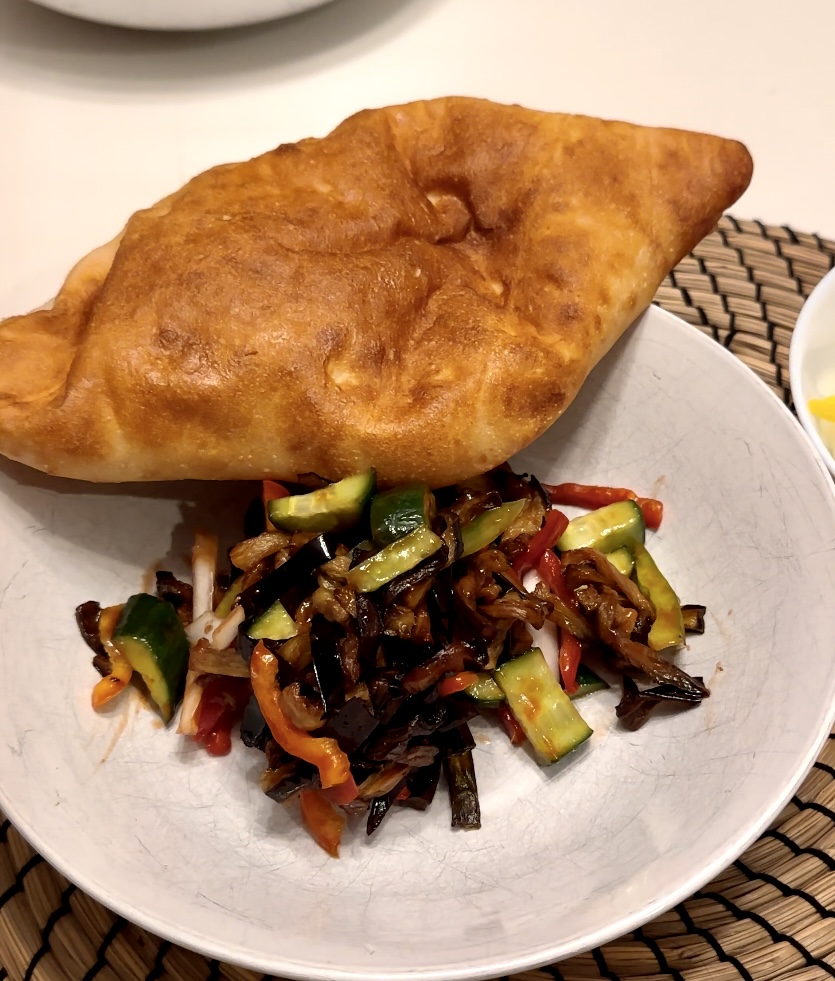
Eggplant Salad
A slight smokey flavor from roasting the eggplant coupled with a tangy dressing is what gives this dish it’s flare. It’s typically enjoyed as a side dish, appetizer, or alongside grilled meats. Warm samoon bread accompanies the salad.
Ingredients:
- 1 large eggplant or 2 to 3 small eggplants
- 3 tablespoons olive oil
- 1/2 teaspoon salt
- 2 cups red bell peppers, julienned
- 1/2 cup red onion, sliced
- 1 cup sliced Persian or curly cucumber
Dressing Ingredients:
- 1/4 cup lemon juice from fresh lemon
- 2 tablespoons pomegranate molasses. Link to purchase: https://amzn.to/4gtEk9z
- 3 tablespoons olive oil
- 1 teaspoon sumac. Link to purchase: https://amzn.to/4jUwdWT
- 1/2 teaspoon salt
Instructions:
- Preheat oven to 400 degrees Fahrenheit.
- Cut eggplant in 3/4 inch to one inch cubes.
- Toss the eggplant in bowl with 3 tablespoons of olive oil and 1/2 teaspoon of salt.
- Roast eggplants for about 45 minutes or until golden brown, flipping a few times.
- Another alternative for the eggplant is to pan fry until they are brown.
- When the eggplant is done, allow to cool.
- Add dressing ingredients in a small bowl and whisk.
- Add all vegetables including eggplant in a large bowl.
- Add the dressing on top of the vegetables.
- Mix and enjoy.
Samoon bread can be found in many middle eastern markets.
Recipe courtesy of MidEastChef. Her website has many Chaldean food recipes.
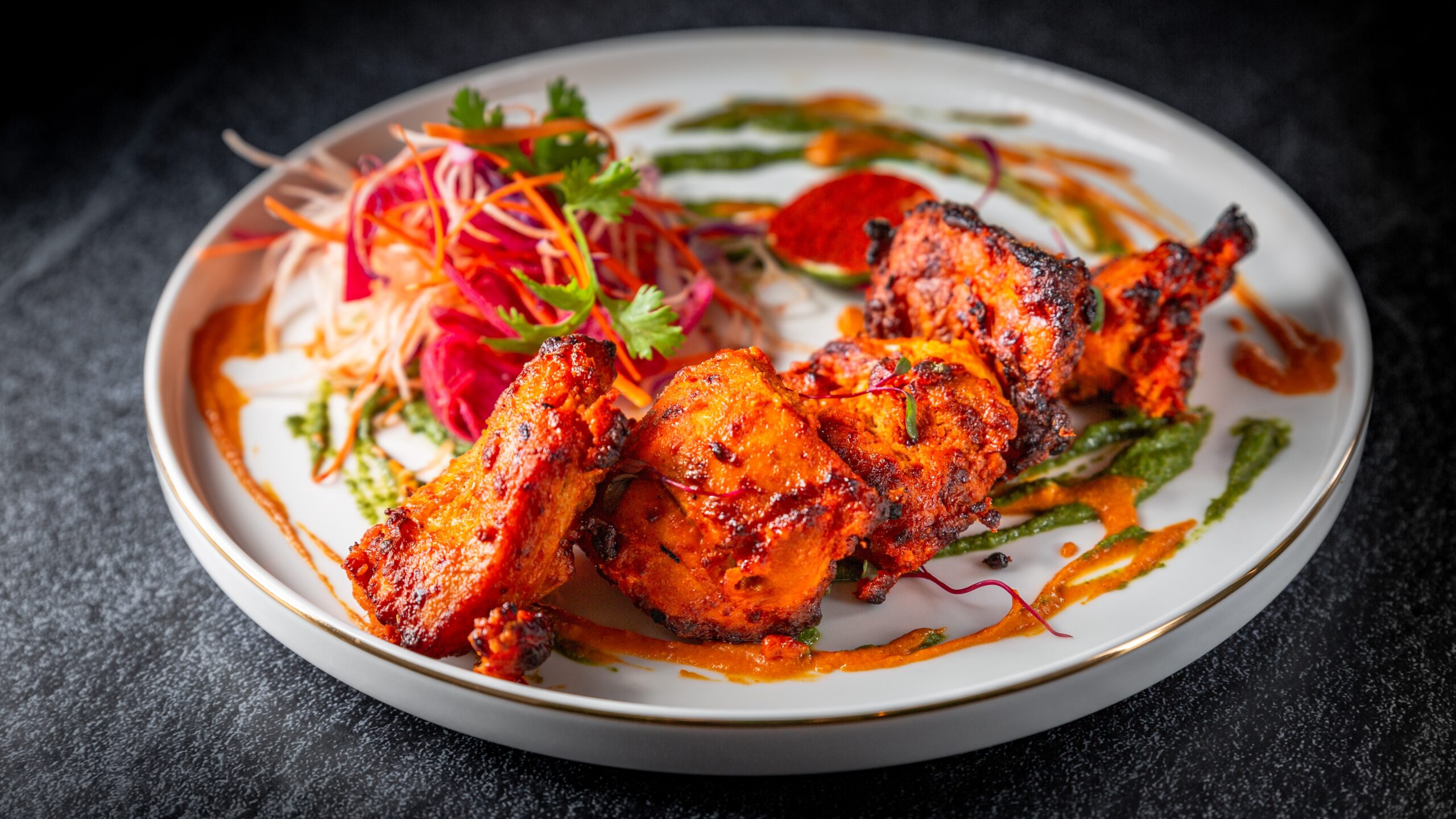
Chicken Tikka
This recipe is popular in most Middle Eastern cultures. Seasoning of bold paprika and cumin with sweet cinnamon dance on your tongue. It’s easy to make. You can substitute lamb or beef.
Ingredients:
- 3 pounds boneless, skinless chicken breast
- 1/2 cup plain, whole milk yogurt
- 3 garlic cloves, minced
- 1 teaspoon paprika
- 1/2 teaspoon cinnamon
- 1/4 teaspoon cumin
- 1 tablespoon olive oil
- 1 tablespoon red wine vinegar
- 1 1/2 teaspoon salt
- 1/2 teaspoon pepper
- 2 tablespoons lemon juice
Instructions:
- Trim the chicken and cut into one-inch cubes.
- Mix all of the ingredients except the chicken in a large bowl.
- Add the chicken to the bowl and mix well to coat the chicken with the sauce.
- Cover and marinate in refrigerator for at least one hour but longer is better – up to overnight.
- When you are done marinating, preheat your grill.
- Put the chicken on skewers.
- Using medium/high heat, grill until chicken is ready, flipping once. It takes about 20 minutes – 10 minutes on each side.
- Serve in a sandwich with garlic paste or eat with yellow rice.
Recipe courtesy of MidEastChef.
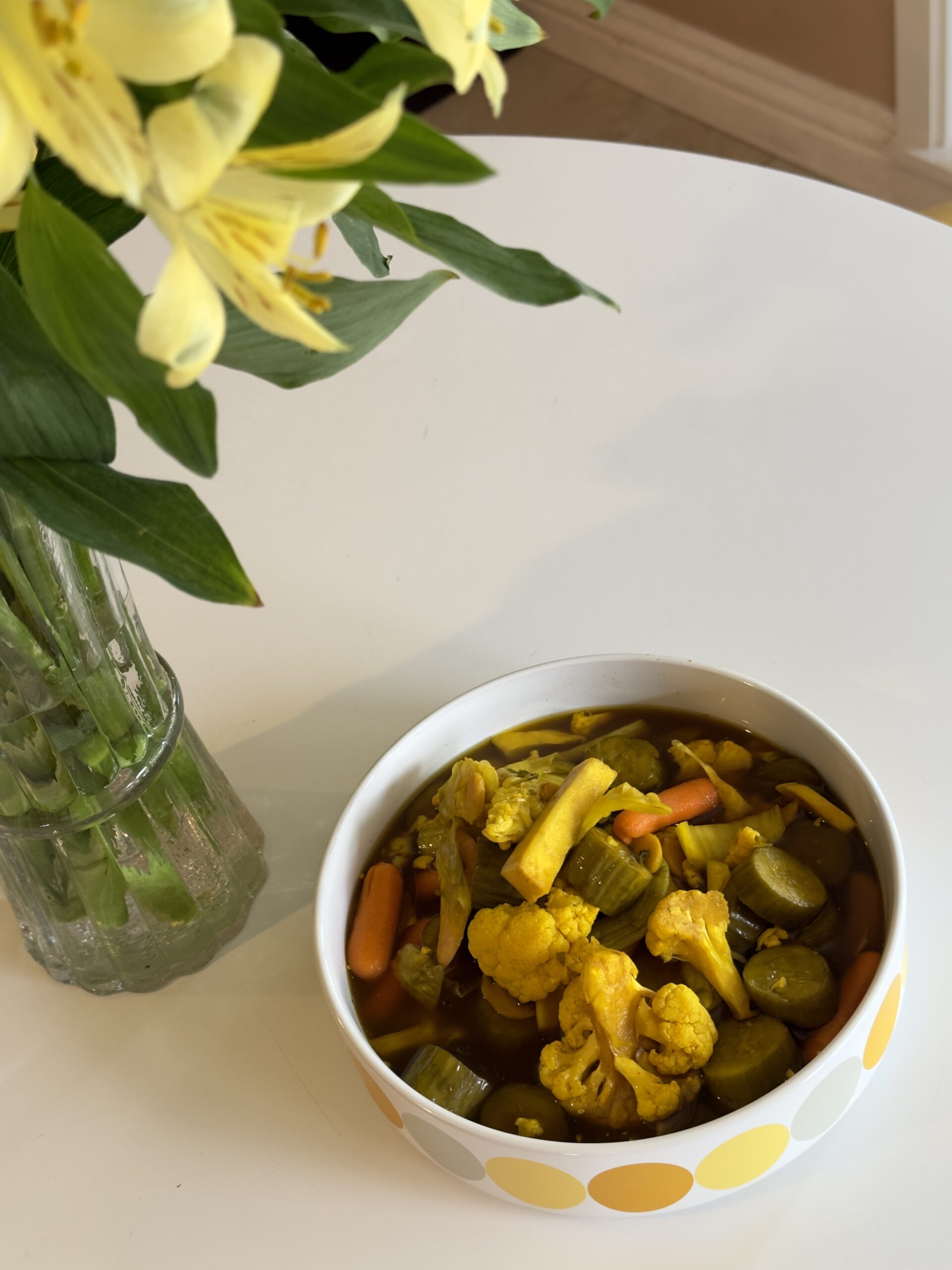
Turshi (Torchi)
This pickled vegetable dish is an essential part of Chaldean food. A staple in households, it’s thought of as a condiment and served at every meal.
Ingredients:
- 4 Persian cucumbers, thickly sliced
- 1 red bell pepper, cut into 1 inch pieces
- 1 large carrot, thickly sliced
- ¼ head of cauliflower, broken into florets
- ⅛ head of green cabbage, cut into 1 inch pieces
- 4 cloves garlic, sliced
- 1 tablespoon curry powder
- 1 tablespoon turmeric
- 1 tablespoon sugar
- ¼ cup salt
- 3 cups vinegar
- 1½ cups water
- ½ cup red wine vinegar
- 1 tablespoon olive oil
Use a large mixing bowl to accommodate all the vegetables and dressing.
Instructions:
- Cut the vegetables and put them in a large mixing bowl.
- Mix the curry powder, turmeric, sugar, and salt in a small bowl.
- Sprinkle the spices over the vegetables and toss to coat.
- Let the vegetables absorb the spices for 20-30 minutes.
- Tip: Re-toss the vegetables occasionally.
- Put the liquid ingredients in a pot large enough to hold your vegetables with the liquid.
- Tip: An enameled pot is best.
- Bring the vinegar mixture to a boil and then add the vegetables.
- Return the pot to a boil and simmer the vegetables for 3 minutes, stirring constantly.
- Remove the vegetables from the liquid and let them both cool down separately.
- Tip: You want the vegetables cooked to crisp tender.
- Note: If you leave the vegetables to cool in the liquid, they will overcook.
- Once the liquid and vegetables are cool store them combined in a sealable jar.
- Tip: To keep the air away from the vegetables while they are pickling, you can cover the surface of the liquid with plastic wrap before sealing the jar.
- Pickle the vegetables for three days in the refrigerator
- Transfer the pickles to a bowl and serve chilled.
Recipe courtesy of Jabberwocky Stew.
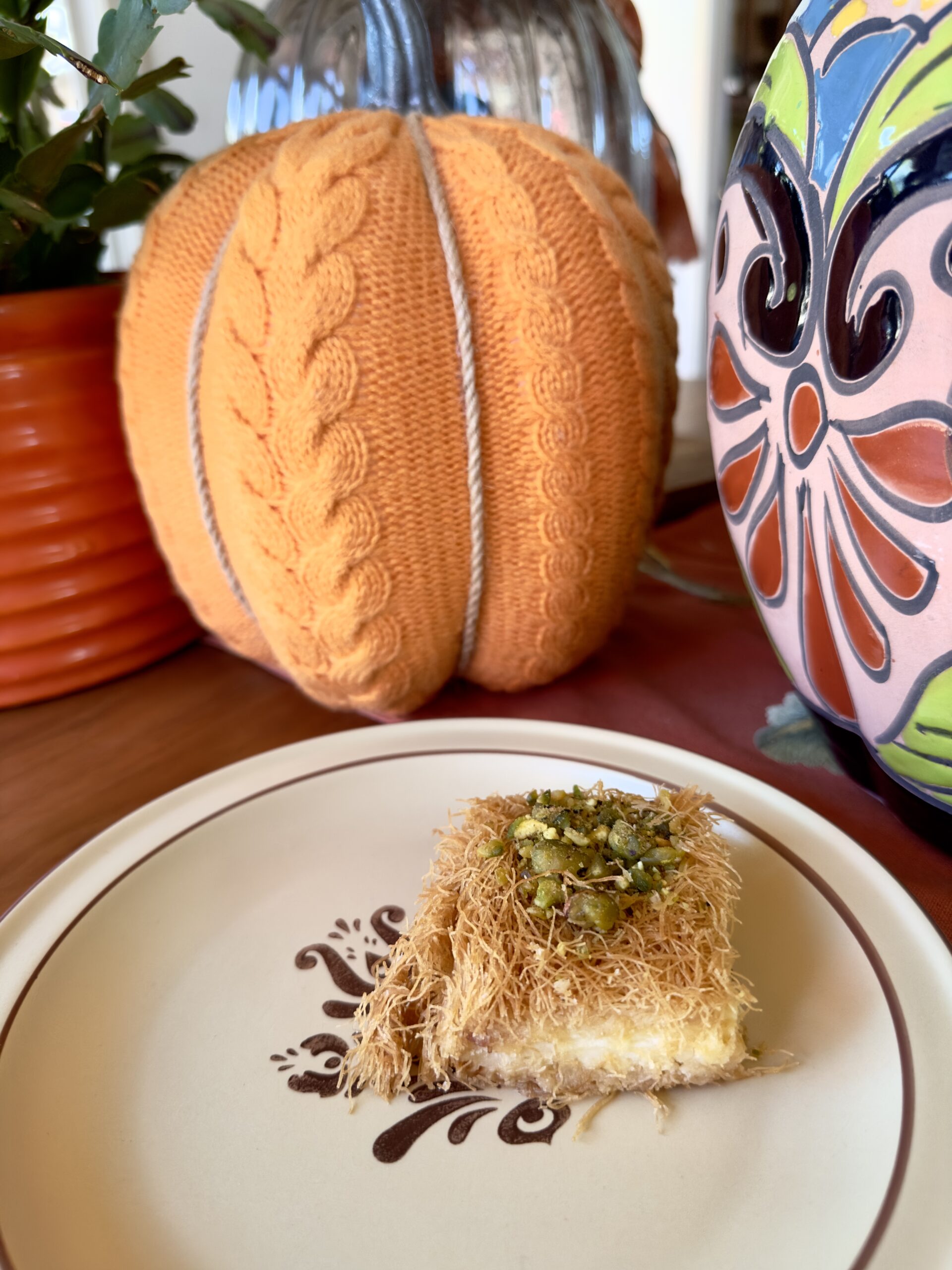
Kunafa
While a tad labor intensive, this Chaldean dessert is worth the effort. Orange blossom and rose water infused syrup give it a distinct floral aroma. Using ghee (clarified butter) instead of traditional butter lends a richer taste.
Kunafa is eaten with hot black tea, coffee, or a side of thickened clotted cream. It’s commonly enjoyed during celebrations, holidays and special occasions like Christmas or weddings.
Ingredients for the syrup:
- 2 cups granulated sugar
- 1 ¼ cup water
- ¼ cup honey
- 1 teaspoon lime juice
Flavoring the syrup:
- 1/2 tablespoon orange blossom water
- 1/2 tablespoon rose water. Link to purchase both water’s: https://amzn.to/4aGbzFH
- OR 1 teaspoon of vanilla extract
Cream filling (Ashta):
- 2 cups whole fat milk
- 3-4 tablespoons corn starch
The kunafa:
- 1 pound kunafa (shredded phyllo dough). Link to purchase: https://amzn.to/3CBgB9F
- 1 cup ghee
Now you can assemble the syrup, filling and kunafa.
Instructions:
The syrup:
- In a saucepan over medium-high heat add sugar, water, honey and your flavors, stir to combine.
- Bring to a boil then add the lemon juice. Turn heat down to low and let it simmer for 10 minutes.
- Turn heat off and let it cool completely and come to room temperature.
The filling:
- In a saucepan whisk together cold milk and cornstarch until dissolved.
- Place on your stovetop on medium heat, keep stirring the mixture until it bubbles and thickens.
- Take off heat, let it cool completely.
The kunafa:
- In a small saucepan melt ghee and let it cool so you can handle.
- Take one half of the thawed kunafa and pulse in your food processor. Make sure not to turn it into powder. If you purchased the already shredded kunafa from the link above, there is no need for this step.
- Place shredded kunafa in a bowl and pulse the other half.
- Pour ¾ of the melted ghee over the kunafa and massage with your hands to spread the ghee evenly.
- Preheat your oven to 350 Fahrenheit.
- Brush a 10” round pan with some of the melted ghee.
- Place half the kunafa in the pan pressing hard with another plate or a measuring cup to spread evenly along the bottom and the sides.
- Pour the pudding mixture on top.
- Spread the filling evenly leaving about half an inch from the top.
- Top with the remaining half of the kunafa, spread evenly pressing lightly with your fingertips.
- Pour the remaining ghee evenly on top.
- Bake in the middle rack for 30 minutes until sides turn brown. Then move it up to brown the top for 10 to 15 minutes.
- Pour cooled syrup over while hot and let it rest for 10 minutes.
- Invert on a serving platter and garnish with crushed pistachios.
Recipe courtesy of Amira’s Pantry.
Trying foods from other cultures not only expands your palette, it gleans perspective into meals countries around the world lovingly share around the table with their families.
Related Posts:
Culture Trip: Twelve Countries, Twelve Traditions
Culture Trip: How to Get the Most From Visiting America’s National & State Parks
Culture Trip: How to Find Italian Fashion For Less

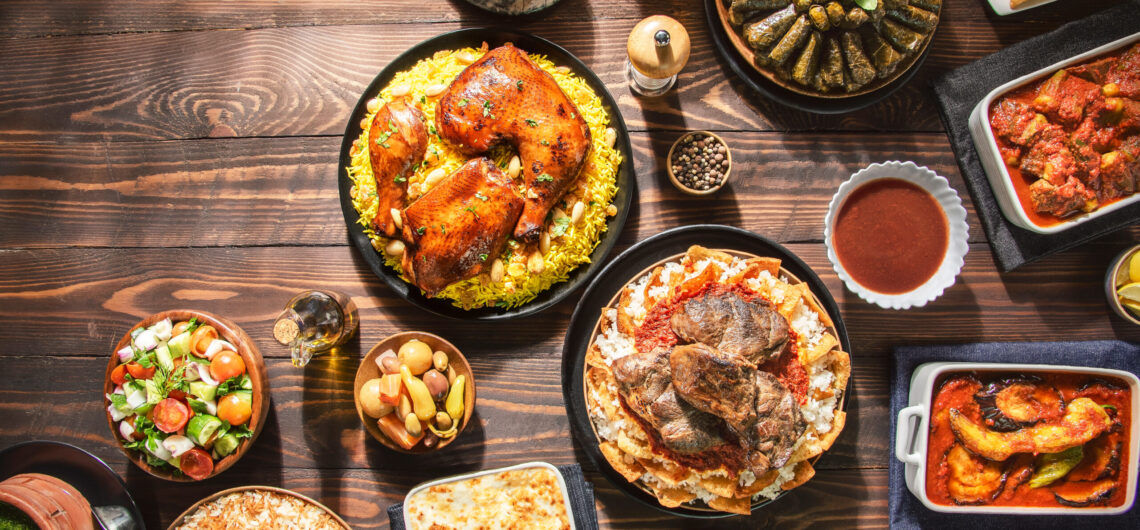
Comments